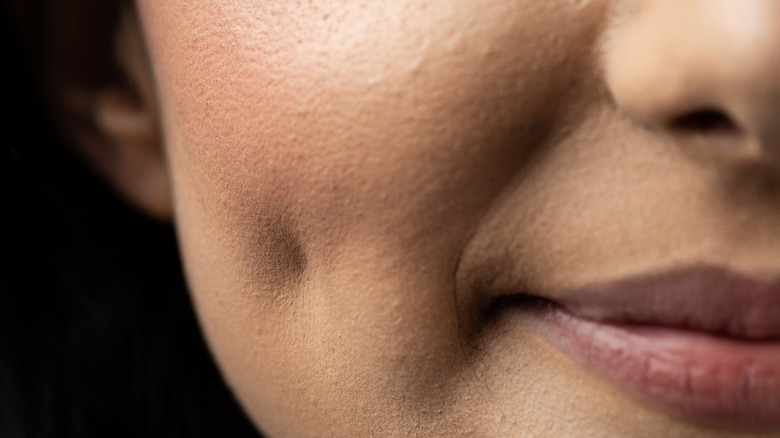Here's Where The Dimples On Your Cheeks Really Come From
You've likely noticed that some people have dimples on their cheeks when they smile while others don't. The small indentations tend to occur in families, which have led to theories that they are hereditary, according to MedlinePlus. In addition to the cheeks, dimples can occur in other parts of the skin, including the chin and lower back (via Healthline). It's also possible to have dimples on one or both sides of the mouth.
Babies will typically have dimples caused by the baby fat in their cheeks, but once they lose this fat as they grow older the dimples can disappear. Others may not have dimples at birth but go on to develop them later in childhood. Some people have dimples only until they reach adolescence, while still others have them throughout their entire life. Dimples are common, though the exact prevalence is unknown. One study of more than 2,300 people published in 2016 found that 37 percent of the participants had cheek dimples.
This is how cheek dimples form
According to Healthline, dimples typically form as a result of an anomaly in a facial muscle called the zygomaticus major. Involved in facial expressions, this muscle is responsible for helping raise the corners of your mouth when you smile.
In a person without dimples, the zygomaticus major begins at a bone in the cheek and runs down the face to the corner of the mouth. In an individual with dimples, this muscle splits on the way down to the mouth, with one section connected at the corner of the mouth and the other connected below the corner of the mouth. It's the movement of skin over this split in the zygomaticus major that causes an indentation and thus a dimple to form.
While some people refer to dimples as a birth defect, Healthline points out that they are not uncommon and that they don't have any negative effects on a person's health.
Are cheek dimples genetic?
"Cheek dimples are a genetically transmitted abnormality of a muscle in the cheek," Brent Moelleken, plastic surgeon and associate clinical professor of surgery at the University of California, Los Angeles, tells Smithsonian Magazine.
Research is limited when it comes to the role that genetics play in the development of dimples, according to MedlinePlus. Yet even so, they are widely thought to be a dominant genetic trait. So what does that mean, exactly? As opposed to a recessive trait — which requires both parents to have the gene in order for it to be inherited — cheek dimples could be handed down from parent to child even if only one parent has the gene (per Science ABC). Similarly, if both parents possess cheek dimples, so will their offspring, notes Smithsonian Magazine.
Overall, however, more study is needed to clarify the role of genetics in the development of dimples.
People who want cheek dimples can get dimpleplasty
Dimpleplasty is an outpatient cosmetic procedure that creates cheek dimples on the face (per Aesthetic Arts Institute of Plastic Surgery). In addition, the surgery can also involve minor narrowing of any rounder portions of the cheeks.
After using anesthesia to numb the area, a 2 to 3-millimeter cut is made inside the cheek, removing a small amount of fat and muscle from the area (via Healthline). In doing so, the surgeon can then fasten a dissolvable suture to put a secure hold on the dimple, according to the Aesthetic Arts Institute of Plastic Surgery. In time, emerging scar tissue will take the place of the sutures, making the dimple permanent.
Although uncommon, complications following the surgery can include bleeding, facial nerve damage, infection, and scarring, according to Healthline. Most often, patients may experience some slight swelling that generally resolves itself within a couple of days and can then resume regular day-to-day activity. In the event of extreme bleeding, or if you notice fluid oozing from the affected area, be sure to seek medical attention.




